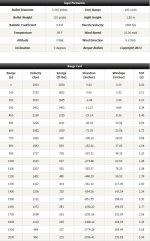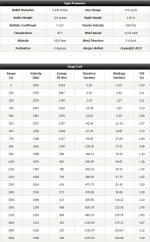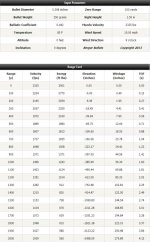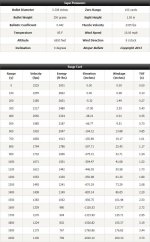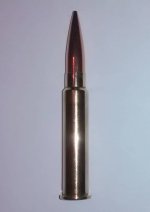2" groups @ 600 yds. won't win unless the conditions are terrible, You had better be in the 1's and a 50 for score , Now we are talking a sling gun ? if I were shooting a 30 it would be a WSM. that is proven to shoot 10 shots in under 3"@ a 1000. Heck I shot 30 shots in an agg. of 3" at 1000 with a light gun and one dropped 1 point with a 103 gr. bullet, and a 299 out of 300.... and the 10 ring is 7"....maybe your 30-30 will beat it .... jim
Jim, you seem to be missing the point. I never said a 2" group would win. I simply said you have 2" plus of drift at 1 mph of wind variation. The 30-30 is as accurate as your 6BRA if not more, and wind drift is about identical. If you don't believe my accuracy statement, then you are in denial. Ask other shooters that have witnessed the accuracy of my 30-30.
Do you understand what I'm saying? If the wind drift and accuracy are the same, then the performance is the same. Where do you think the 30-30 comes up lacking against the 6BRA? Wind drift, or accuracy? What are you questioning here? Do you think I have just been fooling myself for almost 25 years on the 30-30 accuracy, or do you think the wind drift calculations are bogus?
Now for some final thoughts. Jim, why is your argument against the 30-30 even based on whether or not we could ever beat Bart's .3" 600 yard group? Every group ever shot at 600 yards has challenged Bart's .3" group, and failed. I would be surprised if that group doesn't stand as the best ever fired when Christ returns (now I hope you believe me when I say he will). With that line of thinking, our 30-30 will never measure up, but neither will any other 6BRA's. My point is this. It's not about whether a 30-30 ever wins a 600 yard match. Only one 6mm wins at a match. All the others fail to win. It is a fact that the best gun doesn't always win. Actually, the best gun rarely wins, because it is mainly about who gets there shots off in the best timing with the conditions present, even at 100 yards, but more so at 600 yards. Last year I bumped the first place 6 PPC shooter at 200 yards, and took the first place spot. My 30-30 had gone out of tune, but a .8" tall group was better than his 1.6" wide group from his well tuned rifle. Why did I go to the line so out of tune? I thought I had shot a bug hole on target # 4. I had loaded my rounds for target # 5, and was headed to the line when Mark came out with the targets, and said " that would have been a beautiful group if you hadn't put one high in the black". All I could think about was that I had better read those flags well and not shoot wide. Needless to say, it worked.
Jim, like Butch said, don't sell the 30-30 short. I don't dislike you or the 6BRA. I have a lot of respect for the 6 BR, 6 BRA, 6 PPC, and many other cartridges. If I didn't, where would the challenge be? Just remember, it all started with the 30-30 in 1895. It was the first ever smokeless powder sporting cartridge, only now, it can take advantage of modern bullets, barrels, and powders.
Michael


